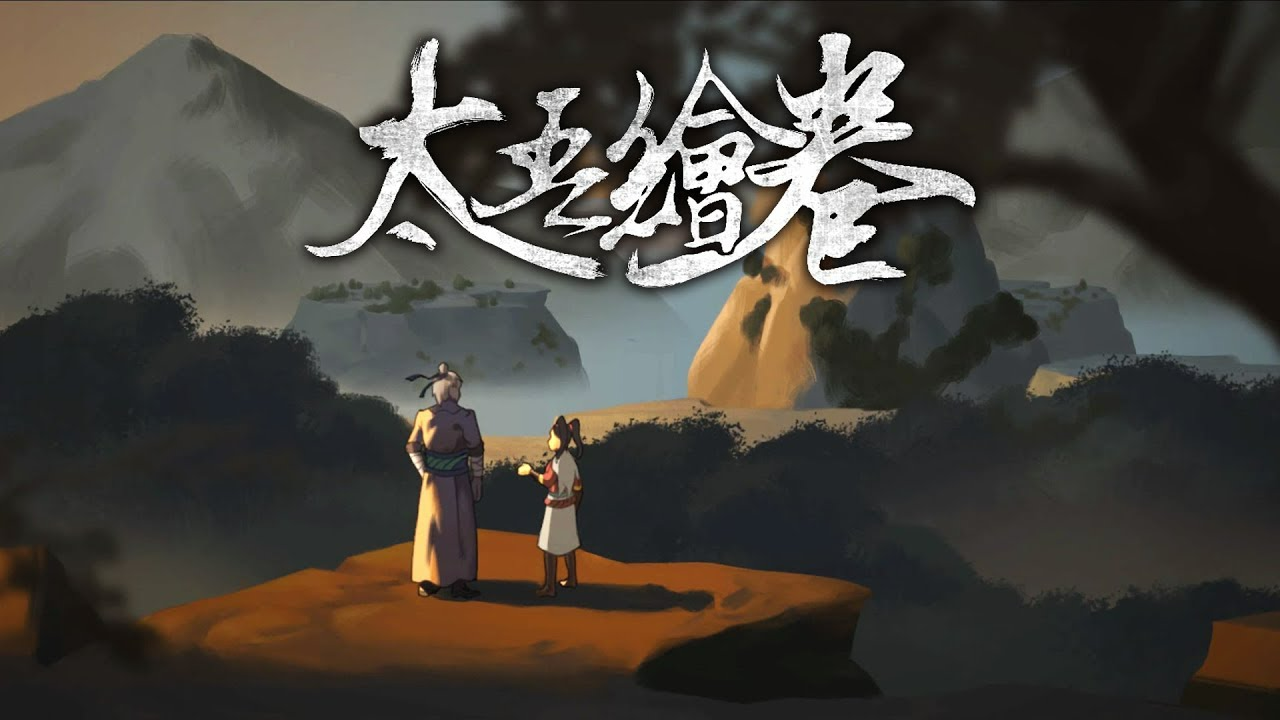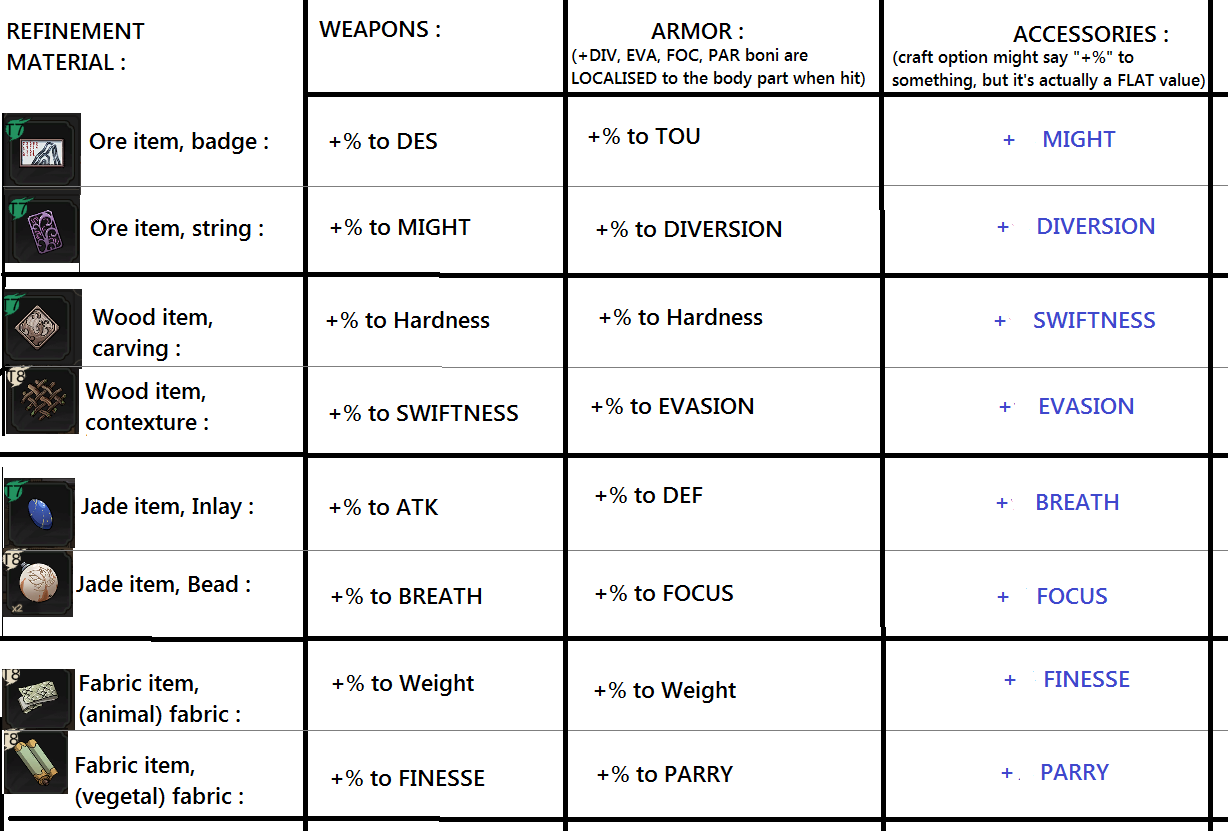A basic guide for crafting and refinement system in The Scroll Of Taiwu.
Introduction
Crafting in Taiwu allows you to produce most items in the game on your own, this guide will briefly explain each crafting skill, what they generally make, how to get materials for crafting, and how you can improve some of your products through refining and other means.
Please note that crafting is an entirely optional part of the game, and everything you can craft can also drop from enemies or be bought, so it is just one of the many ways to get the items you need.
Getting Started
To begin crafting you will need four things, sufficient attainment in the crafting skill, a tool, a material, and a crafting building to carry out your work (you do not need a building to repair/dismantle stuff, but still need skill and tools)
Material is a bit more complicated and deserves its own section, so I will focus on the other three things first.
Tools
Crafting tools are generally grouped by crafting skills, carpentry tools are used for carpentry, forges for blacksmithing, etc…
Tools cannot be crafted, and the easiest way to get them is to buy them from merchants from the appropriate guild. Rejuv Hall sells medicine/poison tools, Pentalake sells weaving tools, and square master sells carpentry/blacksmithing tools, etc… Sword Manor sect tournament is also an easy way to get high-end tools.
Tools all have limited durability, which reduces by 1 for each repair, dismantle, or crafting you’ve done with the tool. As a result, high-end tools should only be used when absolutely necessary, since they can have very low durabilities.
Skills
Crafting skills can be learned by reading crafting skill books, which are most commonly obtainable from swordmanor npc and book merchants. Since skill attainment gained from reading books is largely a percentage increase based on your talent, lacking talent can make it VERY difficult to reach high enough skill to craft top-tier items, so take that into consideration. You need over 400 skills to make the highest tier items, which is very hard to reach even with top tier tools if you don’t at least have 50+ talent, if not more.
There are Taiwu village buildings that help improve skill for the purpose of crafting, and I explained them in more detail in my econ guide, so if you are short on skill attainment you can consider those.
Crafting Building
To craft, you will either need to be in a tile with a crafting building built (most sects will have a few crafting buildings related to their sect’s specialty, like poison for five immortals), or have it built in the taiwu village (which you can access remotely by viewing the taiwu village, but you still need to be in a town to do access taiwu village storage)
Buildings are explained in more detail in my economy guide, but the level of the main crafting building does not matter, you just need to have it to be allowed to craft, though there are other special support buildings that will help make crafting easier. Most powerful ones will allow you to produce item 1 tier higher than the material you used, which is the only 1 to craft tier one items since there is no tier 1 materials.
Obtaining Materials
With tools, skill, and proper building, the last thing you need is materials. Materials are mainly obtained in three ways.
Firstly, when gathering resources on the world map, there is a chance to get materials based on the resource you gather. The more resources the tile you gathered from has, the more likely it is for you to get material, as well as a chance to get better material. You can definitely get t4 material this way, and though I’ve never seen it, T3 material should be possible as well, but most of the time you will be lucky to get T6/T5 materials.
Secondly, you can build resource buildings in taiwu to help you gather materials, this is passive and can produce a whole bunch of decent materials (t6 should be very common), but you will need to level up those buildings and properly staff them to see higher tier stuff, and based on resources in your village, you may not have the option to gather certain material this way. For more info, you can again check out my economy guide.
Lastly, you can buy materials from merchants, pentalake in particular sells a lot of non-medicine materials, which, while expensive, can be a lot more reliable way to obtain high-tier materials than the first two methods if you got the money.
T2 Materials
There is also a special adventure for each category of materials, that you can only get after a natural disaster has struck a region (this can be seen in your monthly feed, you will get a notice along the line of “after the disaster has struck the xxx place, a rare material of certain kind has shown up”
You can go to the region and find an adventure to locate that rare material, which is only available for a limited time (about a year). To be successful in that adventure, you will need high skill in the associated crafting skill, and bringing with you certain materials of another type to help. During the adventure, you will need to use the material you brought at each node to advance, and each advance can net you some material of the category you are seeking. If you have accumulated enough success along the way, at the end you can find a t2 material.
For example, if you are looking for the T2 wood material, you should have high carpentry skills, and bring with you a lot of Iron type materials, the higher tier the better. Essentially the adventure is you making axes with the iron you brought to chop your way through a forest to get to the t2 Tree. (The exact material you should bring is not always obvious, so make sure to read the adventure description.)
Material Types
Materials are generally grouped into a broad category based on their associated crafting skills, and more specific types. The specific type of material used is what ultimately determines the end product. In most cases, each type of material will have variants between tiers 2-8.
For example, Wood and Bamboo are two types of material for the carpentry skill, whereas Fabric comes in animal and vegetal variants (Cooking, Medicine, and poisoning are a bit different and I will explain them separately)
Generally, the two categories allow the same tier of items to be crafted with a different focuses. For example, Wood and linen can both be used to make gloves. Assuming material of the same tier is used, Wood gloves are more hard-hitting and physically damage-focused, and bamboo gloves are quicker hitting but still, physical damage focused, both also have more balanced style allocations. The vegetal fabric Glove is extremely quick, but also almost entirely internal damage focused with a very bad armor pen, and the animal fabric glove is a bit of a hybrid between physical and internal damage, with balanced stats.
These difference in the material allows you to fine-tune products based on your skill and the material available. If this seems too overwhelming for you, a good note to keep in mind is as follows:
- Most material categories have a “hard” subtype, like wood, and a “soft” subtype, like bamboo.
- The hard type tends to lean towards physical damage, defense, and slower but more powerful attacks, the soft type tends toward speed, finesse, and internal damage.
- While subtype matter, the overall category is still the most important, no metal sword will be able to do much if any internal damage, so using “soft” metal will only give you quick-hitting swords. Likewise, you are not making a full physical damage glove out of linen/hide.
- Since usually a player’s build focus on external or internal damage, picking blacksmithing for external gears and sewing for internal can generally be a safe pick.
Crafting
Having prepared all materials, you can now use the craft option in the appropriate crafting building to begin crafting your item.
Preparation
You will need to pick the tool used, the material used, and the type of item you wish to make, note some items have further subtypes (for example, fabric (vegetal) gloves can come in variants focused on quickness or finess)
The attainment you need to craft an item depends on the material used, there will be three thresholds, the bare minimum is what is needed to use the material at all, and will let you make the product 1 tier below the material’s tier. The next level allows you to produce products in the same tier as the material. If you have a special building that lets you produce item 1 tier higher, the third threshold is what you need to produce product 1 tier above that of the material’s tier.
You can check all the above requirements by hovering over the displayed product. Please note that in cases where an item can come in more than one variant, like fabric (vegetal) glove as described above, selecting the variant you want will further increase the attainment threshold required. (if you don’t choose, the result will be random).
Resources
Besides picking materials and tools, you will also need to invest resources into crafting the items, the resource invested will allow you to further fine-tune the product’s stat sometime. In some cases, such as say a wooden carriage, you just need to invest a bunch of wood resources. But in the case of weapons and armors, you can invest some metal, jade, and linen as well, which will affect the item’s final stat somewhat. The effect isn’t super strong but helps with min max
Crafting Time
Investing resources, you can start crafting items, item will be available for pick up usually in 1-3 months if the time required is 0 months (usually for low-tier medicine and most foods), they will be instantly made. You do not need to remain in the area while the item is being made and is free to do whatever you want, just remember to pick up your item.
Please note that the item will be left in the exact location of the crafting building you used, so if you made the item in a sect, you have to go back to that sect to pick up the item. That is why I suggest doing crafting in taiwu village whenever possible, since taiwu village can be remotely accessed from any town.
Improving your Items – Perks and Refinement
Once an item is made, it may gain a special perk, as far as I know, these are entirely random. These perks can be quite powerful, if situational in their niche. Currently, the craftsperson aspiration allows you to reroll an item’s perk if you have 30% progression in that aspiration and have the necessary attainment.
Items can further be refined by using special refinement material. These are not the same material you use for crafting and can be found in adventures, bought from merchants, and obtained from dismantling gears.
Below is a nice refinement table prepared by Neyhoum:
You can place up to 5 refinement materials in any gear to obtain their corresponding effect, but inserting refinement material requires the respective skill of that material, instead of the material of the item. So if you want to place the fabric on a sword, you need to have sewing, not a blacksmith to do so. Higher the tier of the refinement material, the higher the skill requirement.
Please note currently it doesn’t seem stats gained from refinement will show up on your character stats, but they are applied.
Refinement material can be removed or inserted at will, provided you have the material, but each refinement will cost you some basic resources.
Cooking, Poison, and Medicine
Crafting for these are slightly different, as each has more than the usual 2 hard/soft sub-category of materials.
Poison
This is probably the easiest to complain about, poison materials are based on the 6 poison types, and there are 6 categories as a result. Poison mats are special in that they can be used without being made into poison, just less effective. This is also a very smart and easy way for players to tell what mat is for what poison.
The poison crafting building, the cellar is also where you can apply poison to weapons, armor, and food. The effect of poisoning weapons and armor is explained in detail in the combat guide, poisoned food can be used to poison NPC you gifted it to.
Food
Food is broader than poison in that it is generally divided into a few broad categories that all make food with similar effects. For example, fish, crab, and shrimp of different tiers produce dishes with similar effects, while grain types do produces dishes with similar effects.
Since food buffs are relatively minor, the main use of food in my opinion is as strong gifts. Unlike other materials, with enough attainment, you can make extremely high-tier food with extremely low-tier materials. T9 material can make T3 foods if you have extremely high skills (400+). (Having high-tier mats usually just makes the skill requirement lower.) Do note you still need the special +1 product tier building if you want to make t1 food though.
This means it is very easy to craft very high-tier food with basic materials, and it is very easy to have high-end gifts this way. As a result, while food is pretty meh buff item, learning cooking is extremely useful since it makes it incredibly easy to befriend people.
Medicine
Medicine crafting is arguably the most complex since each medicine can essentially be used to make either a higher tier (2 tiers higher than mat) medicine of a certain type (with a very high attainment requirement), or a lower tier(1 tier lower than mat) medicine of another type (with a very low attainment requirement).
Unlike poison, there is no good indication as to what makes what, so I suggest taking a look at all the medicinal materials of various types and making a note of the useful ones. It is, for this reason, I generally buy my medicine, though some of them do give very nice buffs, so you may want to mass-produce them.
Useful Things To Make
All crafting can be a good source of weapon/armor to fit your need, so your choice here largely depends on your build, here I will note some non-weapon/armor items that can be useful.
- Jade – can be used to make many very useful stat-increasing accessories.
- Carpentry – Notable for making carriages that increase your carry capacity and travel speed, if you did not buy a mount, carriages are a must. (Even then, they are still superior to Mount in some aspects.) Carpentry also has all the poison-resist accessories, in case you need them.
- Sewing – With the new aspiration system requiring your char to be dressed in proper clothing for your aspiration, sewing lets you produce these cloths on demand. They can also make many decent accessories, notably animal fabric makes the attack speed increase accessory.
- Food – As mentioned above, the best source of mass-produced gifts for people.
- Poison – For poison build high tier poison is necessary, since a basic attack with poison coated weapon is the best way to apply poison consistently.
- Medicine – If you can find the appropriate formula, attack speed, move speed, and int/ext pen medicines are all very nice.
Blacksmithing generally has the worst utility, it just makes weapons and armor, but for the most external build you probably still going to end up using metal weapons.
Note: Alcohol and Tea, while very useful buff items, are not associated with cooking and cannot be crafted. They are part of the appreciation building chain and can be harvested in two high-tier appreciation buildings.




